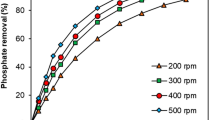Abstract
The ability of ion-exchange resin for ammonia removal from aqueous solution was studied. The results showed that Amberlite ion-exchange resin was effective in removing ammonia from aqueous solution. Factorial design and response surface methodology were applied to evaluate and optimize the effects of pH, resin dose, contact time, temperature and initial ammonia concentration. Low pH condition was preferred with the optimum pH found to be 6. High resin dose generated high removal rate and low exchange capacity. Results of factorial design and response surface methodology showed that temperature was not a significant parameter. The model prediction was in good agreement with observed data (R 2 = 0.957). The optimum Q e was 28.78 mg/g achieved at pH = 6 and initial TAN concentration of 3000 mg/L. The kinetics followed the pseudo-second-order kinetic model (R 2 = 0.999). Equilibrium data were fitted to Langmuir and Freundlich isotherm models with Langmuir model providing a slightly better predication (R 2 = 0.996). The resin was completely regenerated by 2 N H2SO4.







Similar content being viewed by others
References
Bashir MJ, Aziz HA, Yusoff MS, Huqe AA, Mohajeri S (2010a) Effects of ion exchange resins in different mobile ion forms on semi-aerobic landfill leachate treatment. Water Sci Technol 61:641–649. doi:10.2166/wst.2010.867
Bashir MJK, Aziz HA, Yusoff MS, Adlan MN (2010b) Application of response surface methodology (RSM) for optimization of ammoniacal nitrogen removal from semi-aerobic landfill leachate using ion exchange resin. Desalination 254:154–161. doi:10.1016/j.desal.2009.12.002
Bernal MP, Lopez-Real JM (1993) Natural zeolites and sepiolite as ammonium and ammonia adsorbent materials. Bioresour Technol 43:27–33. doi:10.1016/0960-8524(93)90078-p
Cheremisinoff NP (2001) Handbook of water and wastewater treatment technologies. Butterworth-Heinemann, Woburn, MA, USA
Ding Y, Sartaj M (2015) Statistical analysis and optimization of ammonia removal from aqueous solution by zeolite using factorial design and response surface methodology. J Environ Chem 3:807–814. doi:10.1016/j.jece.2015.03.025
Dong S, Sartaj M (2016) Statistical analysis and optimization of ammonia removal from landfill leachate by sequential microwave/aeration process using factorial design and response surface methodology. J Environ Chem Eng 4:100–108. doi:10.1016/j.jece.2015.10.029
Dow Chemical Company (2013) http://www.dowwaterandprocess.com/en/Products/A/AMBERLITE_IR120_H
Du Q, Liu S, Cao Z, Wang Y (2005) Ammonia removal from aqueous solution using natural Chinese clinoptilolite. Sep Purif Technol 44:229–234. doi:10.1016/j.seppur.2004.04.011
Gotvajn AZ, Tisler T, Zagorc-Koncan J (2009) Comparison of different treatment strategies for industrial landfill leachate. J Hazard Mater 162:1446–1456. doi:10.1016/j.jhazmat.2008.06.037
Ho YS, McKay G (1999) Pseudo-second order model for sorption processes. Process Biochem 34:451–465
Jorgensen TC, Weatherley LR (2003) Ammonia removal from wastewater by ion exchange in the presence of organic contaminants. Water Res 37:1723–1728. doi:10.1016/s0043-1354(02)00571-7
Karadag D, Koc Y, Turan M, Armagan B (2006) Removal of ammonium ion from aqueous solution using natural Turkish clinoptilolite. J Hazard Mater 136:604–609
Karadag D, Tok S, Akgul E, Turan M, Ozturk M, Demir A (2008) Ammonium removal from sanitary landfill leachate using natural Gördes clinoptilolite. J Hazard Mater 153:60–66
Lee SM, Jung JY, Chung YC (2000) Measurement of ammonia inhibition of microbial activity in biological wastewater treatment process using dehydrogenase assay. Biotechnol Lett 22:991–994
Lei L, Li X, Zhang X (2008) Ammonium removal from aqueous solutions using microwave-treated natural Chinese zeolite. Sep Purif Technol 58:359–366. doi:10.1016/j.seppur.2007.05.008
Letterman RD (1999) Water quality and treatment: a handbook of community water supplies. McGraw-Hill, New York
Lin SH, Wu CL (1996) Ammonia removal from aqueous solution by ion exchange. Ind Eng Chem Res 35:553–558
Lin L, Wan C, Lee D-J, Lei Z, Liu X (2014) Ammonium assists orthophosphate removal from high-strength wastewaters by natural zeolite. Sep Purif Technol 133:351–356. doi:10.1016/j.seppur.2014.07.010
Liu CH, Lo KV (2001) Ammonia removal from composting leachate using zeolite. I. Characterization of the zeolite. J Environ Sci Health A 36:1671–1688. doi:10.1081/ese-100106251
Liu J, Luo J, Zhou J, Liu Q, Qian G, Xu ZP (2012) Inhibitory effect of high-strength ammonia nitrogen on bio-treatment of landfill leachate using EGSB reactor under mesophilic and atmospheric conditions. Bioresour Technol 113:239–243
Marttinen S, Kettunen R, Sormunen K, Soimasuo R, Rintala J (2002) Screening of physical–chemical methods for removal of organic material, nitrogen and toxicity from low strength landfill leachates. Chemosphere 46:851–858
Montgomery DC (2008) Design and analysis of experiments. Wiley, New York
Nair A, Sartaj M, Kennedy K, Coelho NM (2014) Enhancing biogas production from anaerobic biodegradation of the organic fraction of municipal solid waste through leachate blending and recirculation. Waste Manag Res 32:939–946. doi:10.1177/0734242X14546036
Ölmez T (2009) The optimization of Cr(VI) reduction and removal by electrocoagulation using response surface methodology. J Hazard Mater 162:1371–1378
Rahmani A, Mahvi A, Mesdaghinia A, Nasseri S (2004) Investigation of ammonia removal from polluted waters by Clinoptilolite zeolite. Int J Environ Sci Technol 1:125–133
Randall D, Tsui T (2002) Ammonia toxicity in fish. Mar Pollut Bull 45:17–23
Sapsford R, Jupp V (2006) Data collection and analysis. Sage, Beverly Hills
Sharma S, Malik A, Satya S (2009) Application of response surface methodology (RSM) for optimization of nutrient supplementation for Cr(VI) removal by Aspergillus lentulus AML05. J Hazard Mater 164:1198–1204
Umpleby RJ II, Baxter SC, Rampey AM, Rushton GT, Chen Y, Shimizu KD (2004) Characterization of the heterogeneous binding site affinity distributions in molecularly imprinted polymers. J Chromatogr B 804:141–149
Wang YF, Lin F, Pang WQ (2007) Ammonium exchange in aqueous solution using Chinese natural clinoptilolite and modified zeolite. J Hazard Mater 142:160–164
Xu C, Wang J, Yang T, Chen X, Liu X, Ding X (2014) Adsorption of uranium by amidoximated chitosan-grafted polyacrylonitrile, using response surface methodology. Carbohydr Polym 121:79–85
Zhang L, Zhang H, Guo W, Tian Y (2013) Sorption characteristics and mechanisms of ammonium by coal by-products: slag, honeycomb-cinder and coal gangue. Int J Environ Sci Technol 10:1309–1318
Acknowledgments
Financial support provided by Ontario Research Fund-Research Excellence (ORF-RE02-007) is acknowledged and appreciated.
Author information
Authors and Affiliations
Corresponding author
Rights and permissions
About this article
Cite this article
Ding, Y., Sartaj, M. Optimization of ammonia removal by ion-exchange resin using response surface methodology. Int. J. Environ. Sci. Technol. 13, 985–994 (2016). https://doi.org/10.1007/s13762-016-0939-x
Received:
Revised:
Accepted:
Published:
Issue Date:
DOI: https://doi.org/10.1007/s13762-016-0939-x




